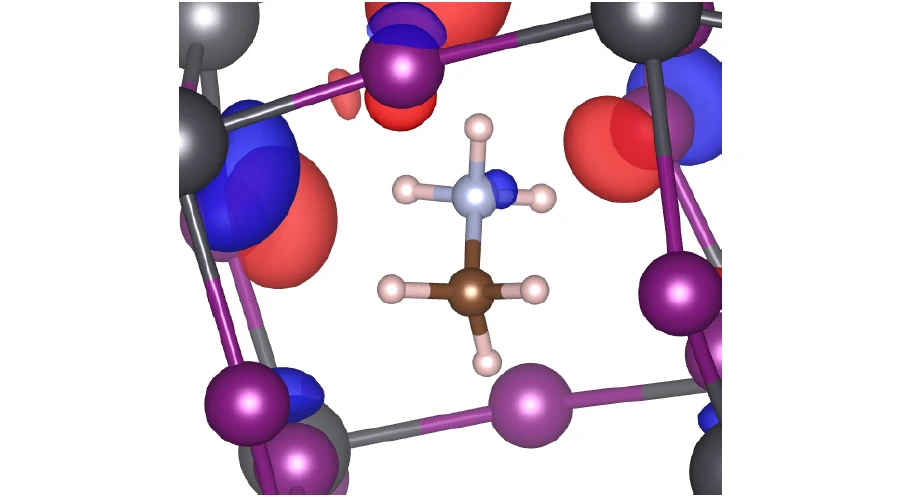Perovskite solar cells: Hydrogen bonds measured
Research results provide important information for perovskites materials research for solar cells
The evaluation of X-ray measurements on methylammonium perovskite semiconductors now shows what role hydrogen bonds play in these materials. In addition, the HZB team showed that radiation damage by soft X-rays to this sensitive class of materials occurs even faster than often expected. Both results provide important information for perovskites materials research for solar cells.
Metal halide perovskite (MHP) solar cells are being rapidly and intensively developed in labs around the world. This class of materials is inexpensive, easy to process, and has achieved efficiencies of over 20 percent after only a few years of development. By varying the chemical composition, the optoelectronic properties can be precisely matched to the sunlight and to the particular application. The highest efficiencies are achieved by hybrid perovskites containing methylammonium cations (MA), but the presence of MA is also associated with instability.
Signature of hydrogen bonds unveiled
Now, an international collaboration including the HZB’s Department Interface Design, led by Marcus Bär, has used soft x-ray emission spectroscopy (XES) combined with advanced theoretical modelling to gain new insights into the electronic structure and, in particular, the hydrogen bonds within methylammonium-lead-iodide perovskite films. The samples came from the laboratory of perovskite pioneer Henry Snaith, Oxford University, and the measurements were performed during (pre-pandemic) beamtime at the Advanced Light Source at Lawrence Berkeley National Laboratory. They have now published the results of the study which draws on modelling of the electronic structure and the ultrafast movement of hydrogen atoms within the structure by Swedish collaborator Michael Odelius, Uppsala University.
"By combining site- and element-specific soft X-ray spectroscopic measurements with molecular dynamics and density functional theory modelling, we have now been able to provide new insights into the electronic structure and dynamics of the organic MHP component," says Regan Wilks, HZB physicist and first author of the study. In particular, the group succeeded in detecting spectral signatures of the hydrogen bonds between the organic methylammonium molecule and the inorganic framework of the perovskite, and saw evidence for significant dynamic changes in the structure induced during the measurement on the femtosecond time scale.
Speedy damage
To separate these ultrafast signals from the effects of damage by the high intensity synchrotron x-ray beam, the group also thoroughly characterized these damage effects, showing that they can occur on the time scale of 100 ms, much faster than the duration of a standard experiment. The speed of this damage effect means that it can in effect be “invisible” unless the experiment is conducted with great care – by the time the measurement begins to yield results, the damage is already done. "It’s important to document these effects in a publication, even if it is not the most scientifically interesting result, because it can be very important information to other groups who might want to perform similar experiments or confirm our results," Wilks points out. To avoid the radiation damage and thus artefacts during the measurement, the sample under the soft X-ray beam was moved perpendicular to the photon beam during the measurement keeping the irradiation of any point to a fraction of a second.
Publication:
Journal of Physical Chemistry Letters (2021): Dynamic Effects and Hydrogen Bonding in Mixed-Halide Perovskite Solar Cell Absorbers
Regan G. Wilks, Axel Erbing, Golnaz Sadoughi, David E. Starr, Evelyn Handick, Frank Meyer, Andreas Benkert, Marcella Iannuzzi, Dirk Hauschild, Wanli Yang, Monika Blum, Lothar Weinhardt, Clemens Heske, Henry J. Snaith, Michael Odelius, and Marcus Bär
DOI: 10.1021/acs.jpclett.1c00745
Contact:
Helmholtz-Zentrum Berlin für Materialien und Energie
Department Interface Design
Dr. Regan Wilks
Phone +49 30 8062-13503
Email: regan.wilks(at)helmholtz-berlin.de
Prof. Dr. Marcus Bär
Phone +49 30 8062-15641
Email: marcus.baer(at)helmholtz-berlin.de
Press release HZB, 26 May 2021
